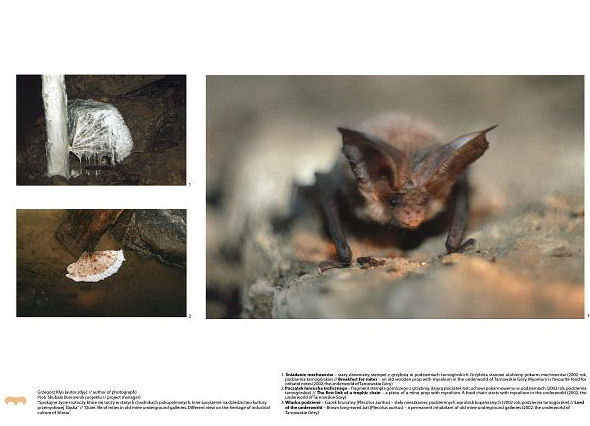
Description popularizing the research project
When last tourists leave the galleries of the monumental mine and the lights are off, life of inhabitants of the old dark drifts returns to equilibrium. What may be going on in the impenetrable darkness? It is hard to expect such spectacular scenes as the ones in ‘Jungle Book’. But even there in the dark a food chain is being forged. Enormous mycelium growing on old props forms the first link. They rather inspire disgust than admiration so the floodlights mercifully concentrate on interesting dripstone formations instead. Nevertheless the fungi are favorite food for organisms of the next link, for primitive moss mites. These relatives of spiders, scorpions and ticks found home here in eternal darkness far from the sunlight. These tiny arachnids adapted to the new environment as they had been brought there by a man and some of them stayed there. There are 41 species of moss mites that inhabit the underworld of Tarnowskie Góry. It is not a great number in comparison with a few hundred species living in Poland. But you can find there such rarities as species which occur only in one of reserves in Beskidy. Moreover some of the species do not live anywhere else in Poland.
When the last tourists leave the underworld, an ancient kobold starts making rounds of his realm. Bats are flapping their leathery wings around him when he is walking along the empty corridors. Miners left their work a long time ago and now only tourists visit the place. Now the ancient guardian takes care of tiny creatures which are never mentioned by guides. Tourists also never take pictures of them, not realizing that they are a part of the mining heritage as well. There are not many troglobionts i.e. animals connected with caves and caverns, in Poland. This makes the inhabitants of the excavations in Tarnowskie Góry even more precious.
Abstract
The research was conducted in the underworld of Tarnowskie Góry (Upper Silesia). The exploitation of natural resources (silver, lead and copper) began in this region in the Middle Ages. Nowadays, Tarnowskie Góry is well known for the huge system of old abandoned underground workings. It is the biggest such a system in Poland and one of the largest in Europe. The total length of underground galleries is over 300 km. Samples of organic matter were collected on eight sites. They were situated at a succeeding distance from the entrance (up to 5 km) and at depth of 40 to 60 m. One of the sampling site was placed in the monumental mine, is been frequently visited by tourists.
Taking into consideration distribution of mites in the monumental mine, human transportation seems to be a very important source of mite's dispersal. Mite fauna recorded in mine galleries in Tarnowskie Góry and Kletno is poor with regard to their abundance. On the other hand, some species occurring in mine galleries are interesting from a faunistic and ecological point of view. None of the 41 oribatid species recorded in the mine galleries could be regarded as a typical troglobiotic mite, however, Medioppia beskidyensis Niemi et Skubała, 1993 can fulfill such function. The species is known only from the site of description - the "Pod Rysianką" reserve. Two species are new for the Polish fauna and four oribatids were recorded for the first time in Upper Silesia.

